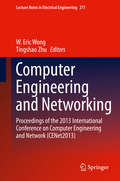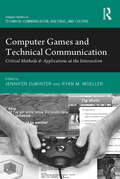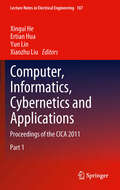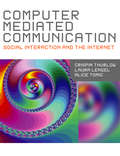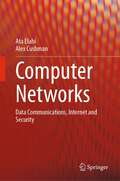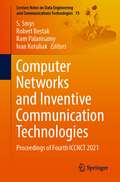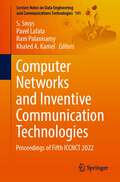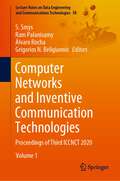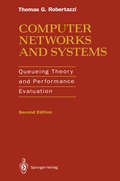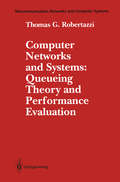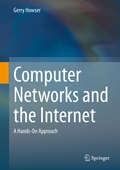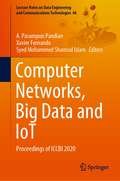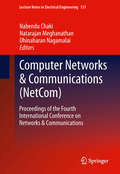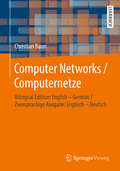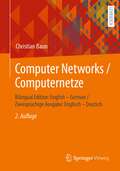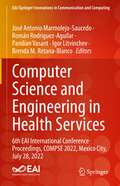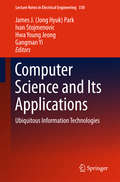- Table View
- List View
Computer Engineering and Networking: Proceedings of the 2013 International Conference on Computer Engineering and Network (CENet2013) (Lecture Notes in Electrical Engineering #10152)
by W. Eric Wong Tingshao ZhuThis book aims to examine innovation in the fields of computer engineering and networking. The book covers important emerging topics in computer engineering and networking, and it will help researchers and engineers improve their knowledge of state-of-art in related areas. The book presents papers from The Proceedings of the 2013 International Conference on Computer Engineering and Network (CENet2013) which was held on 20-21 July, in Shanghai, China.
Computer Flowchart (large print)
by RnibThis flowchart diagram shows, in a typical system, what peripheral components are attached to a computer and how data, represented by arrows, moves between them and the computer. Each element in the diagram is shown as a rectangle. There is a locator dot shown, which will be at the top left of the page when the image is the right way up. In the centre of the page is the computer (processor) shown in a striped texture. To the left of this is a keyboard and mouse with arrows pointing right from them to the computer. To the right is a CD-ROM with an arrow pointing to the computer, and a disc drive with arrows pointing to and from the computer. There are arrows pointing from the computer up the page to the screen and down the page to a printer.
Computer Flowchart (UEB contracted)
by RnibThis flowchart diagram shows, in a typical system, what peripheral components are attached to a computer and how data, represented by arrows, moves between them and the computer. Each element in the diagram is shown as a rectangle. There is a locator dot shown, which will be at the top left of the page when the image is the right way up. In the centre of the page is the computer (processor) shown in a striped texture. To the left of this is a keyboard and mouse with arrows pointing right from them to the computer. To the right is a CD-ROM with an arrow pointing to the computer, and a disc drive with arrows pointing to and from the computer. There are arrows pointing from the computer up the page to the screen and down the page to a printer.
Computer Flowchart (UEB uncontracted)
by RnibThis flowchart diagram shows, in a typical system, what peripheral components are attached to a computer and how data, represented by arrows, moves between them and the computer. Each element in the diagram is shown as a rectangle. There is a locator dot shown, which will be at the top left of the page when the image is the right way up. In the centre of the page is the computer (processor) shown in a striped texture. To the left of this is a keyboard and mouse with arrows pointing right from them to the computer. To the right is a CD-ROM with an arrow pointing to the computer, and a disc drive with arrows pointing to and from the computer. There are arrows pointing from the computer up the page to the screen and down the page to a printer.
Computer Games and Technical Communication: Critical Methods and Applications at the Intersection (Routledge Studies in Technical Communication, Rhetoric, and Culture)
by Jennifer deWinter Ryan M. MoellerTaking as its point of departure the fundamental observation that games are both technical and symbolic, this collection investigates the multiple intersections between the study of computer games and the discipline of technical and professional writing. Divided into five parts, Computer Games and Technical Communication engages with questions related to workplace communities and gamic simulations; industry documentation; manuals, gameplay, and ethics; training, testing, and number crunching; and the work of games and gamifying work. In that computer games rely on a complex combination of written, verbal, visual, algorithmic, audio, and kinesthetic means to convey information, technical and professional writing scholars are uniquely poised to investigate the intersection between the technical and symbolic aspects of the computer game complex. The contributors to this volume bring to bear the analytic tools of the field to interpret the roles of communication, production, and consumption in this increasingly ubiquitous technical and symbolic medium.
Computer Games and Technical Communication: Critical Methods and Applications at the Intersection (Routledge Studies in Technical Communication, Rhetoric, and Culture)
by Jennifer deWinter Ryan M. MoellerTaking as its point of departure the fundamental observation that games are both technical and symbolic, this collection investigates the multiple intersections between the study of computer games and the discipline of technical and professional writing. Divided into five parts, Computer Games and Technical Communication engages with questions related to workplace communities and gamic simulations; industry documentation; manuals, gameplay, and ethics; training, testing, and number crunching; and the work of games and gamifying work. In that computer games rely on a complex combination of written, verbal, visual, algorithmic, audio, and kinesthetic means to convey information, technical and professional writing scholars are uniquely poised to investigate the intersection between the technical and symbolic aspects of the computer game complex. The contributors to this volume bring to bear the analytic tools of the field to interpret the roles of communication, production, and consumption in this increasingly ubiquitous technical and symbolic medium.
Computer, Informatics, Cybernetics and Applications: Proceedings of the CICA 2011 (Lecture Notes in Electrical Engineering #107)
by Xingui He, Ertian Hua, Yun Lin and Xiaozhu LiuThe Conference on Computer, Informatics, Cybernetics and Applications 2011 aims to facilitate an exchange of information on best practices for the latest research advances in the area of computer, informatics, cybernetics and applications, which mainly includes computer science and engineering, informatics, cybernetics, control systems, communication and network systems, technologies and applications, others and emerging new topics.
Computer Keyboard Overview Diagram (large print)
by RnibThis diagram shows an overview of a computer keyboard layout in blocks. Keys which are immediately adjacent to each other are shown as a block of continuous texture or colour. There is a locator dot shown, which will be at the top left of the page when the image is the right way up. In the bottom left of the image is the biggest block, block 1 the main keyboard (alphabet, numbers and punctuation keys). Up from block 1 is block 2, the top line of keys (escape key, function keys). To the right of block 2 is block 3, the three system keys. Down from here is block 4, the six pack. Down again is block 5, the arrow cursor keys. On the far right of the image is block 6, the number pad. At the bottom of the page is a short key which names the blocks.
Computer Keyboard Overview Diagram (UEB contracted)
by RnibThis diagram shows an overview of a computer keyboard layout in blocks. Keys which are immediately adjacent to each other are shown as a block of continuous texture or colour. There is a locator dot shown, which will be at the top left of the page when the image is the right way up. In the bottom left of the image is the biggest block, block 1 the main keyboard (alphabet, numbers and punctuation keys). Up from block 1 is block 2, the top line of keys (escape key, function keys). To the right of block 2 is block 3, the three system keys. Down from here is block 4, the six pack. Down again is block 5, the arrow cursor keys. On the far right of the image is block 6, the number pad. At the bottom of the page is a short key which names the blocks.
Computer Keyboard Overview Diagram (UEB uncontracted)
by RnibThis diagram shows an overview of a computer keyboard layout in blocks. Keys which are immediately adjacent to each other are shown as a block of continuous texture or colour. There is a locator dot shown, which will be at the top left of the page when the image is the right way up. In the bottom left of the image is the biggest block, block 1 the main keyboard (alphabet, numbers and punctuation keys). Up from block 1 is block 2, the top line of keys (escape key, function keys). To the right of block 2 is block 3, the three system keys. Down from here is block 4, the six pack. Down again is block 5, the arrow cursor keys. On the far right of the image is block 6, the number pad. At the bottom of the page is a short key which names the blocks.
Computer Mediated Communication
by Crispin Thurlow Dr Lara M. Lengel Professsor Alice TomicThis book offers students a task-based introduction to Computer-Mediated Communication and the impact of the internet on social interaction. Divided into four parts which require students to learn, (theory), critique, (current issues), explore, (methods), and reflect, (practice), the book aims to: Provide a foundation to the social and communicative nature of information and communication technologies Enable students to engage with the key theoretical issues associated with CMC Equip students with the necessary research and technical skills as a stimulus to independent enquiry. In spite of the rapidly increasing interest in Internet Studies and CMC and the introduction of many university courses in the area, no specialised, introductory textbook exists. This coursebook responds to the need for such a text. Aimed primarily at communication students, this book would also be useful as a sourcebook for students of media, sociology, psychology and English Language Studies. Companion website resources can be found at http://crispinthurlow.net/cmc/
Computer Mediated Communication (PDF)
by Crispin Thurlow Dr Lara M. Lengel Professsor Alice TomicThis book offers students a task-based introduction to Computer-Mediated Communication and the impact of the internet on social interaction. Divided into four parts which require students to learn, (theory), critique, (current issues), explore, (methods), and reflect, (practice), the book aims to: Provide a foundation to the social and communicative nature of information and communication technologies Enable students to engage with the key theoretical issues associated with CMC Equip students with the necessary research and technical skills as a stimulus to independent enquiry. In spite of the rapidly increasing interest in Internet Studies and CMC and the introduction of many university courses in the area, no specialised, introductory textbook exists. This coursebook responds to the need for such a text. Aimed primarily at communication students, this book would also be useful as a sourcebook for students of media, sociology, psychology and English Language Studies. Companion website resources can be found at http://crispinthurlow. net/cmc/
Computer Networks: Data Communications, Internet and Security
by Ata Elahi Alex CushmanThe hands-on textbook covers both the theory and applications of data communications, the Internet, and network security technology, following the ACM guideline for courses in networking. The content is geared towards upper undergraduate and graduate students in information technology, communications engineering, and computer science. The book is divided into three sections: Data Communications, Internet Architecture, and Network Security. Topics covered include flow control and reliable transmission; modulation, DSL, cable modem, and FTTH; Ethernet and Fast Ethernet; gigabit and 10 gigabit Ethernet; and LAN interconnection devices, among others. The book also covers emerging topics such as IPv6 and software defined networks. The book is accompanied with a lab manual which uses Wireshark, Cisco Packet Tracer, and virtual machines to lead students through simulated labs.
Computer Networks and Inventive Communication Technologies: Proceedings of Fourth ICCNCT 2021 (Lecture Notes on Data Engineering and Communications Technologies #75)
by S. Smys Robert Bestak Ram Palanisamy Ivan KotuliakThis book is a collection of peer-reviewed best-selected research papers presented at 4th International Conference on Computer Networks and Inventive Communication Technologies (ICCNCT 2021). The book covers new results in theory, methodology, and applications of computer networks and data communications. It includes original papers on computer networks, network protocols and wireless networks, data communication technologies, and network security. The proceedings of this conference are a valuable resource, dealing with both the important core and the specialized issues in the areas of next-generation wireless network design, control, and management, as well as in the areas of protection, assurance, and trust in information security practice. It is a reference for researchers, instructors, students, scientists, engineers, managers, and industry practitioners for advanced work in the area.
Computer Networks and Inventive Communication Technologies: Proceedings of Fifth ICCNCT 2022 (Lecture Notes on Data Engineering and Communications Technologies #141)
by S. Smys Pavel Lafata Ram Palanisamy Khaled A. KamelThis book is a collection of peer-reviewed best selected research papers presented at 5th International Conference on Computer Networks and Inventive Communication Technologies (ICCNCT 2022). The book covers new results in theory, methodology, and applications of computer networks and data communications. It includes original papers on computer networks, network protocols and wireless networks, data communication technologies, and network security. The proceedings of this conference is a valuable resource, dealing with both the important core and the specialized issues in the areas of next generation wireless network design, control, and management, as well as in the areas of protection, assurance, and trust in information security practice. It is a reference for researchers, instructors, students, scientists, engineers, managers, and industry practitioners for advance work in the area.
Computer Networks and Inventive Communication Technologies: Proceedings of Third ICCNCT 2020 (Lecture Notes on Data Engineering and Communications Technologies #58)
by S. Smys Ram Palanisamy Álvaro Rocha Grigorios N. BeligiannisThis book is a collection of peer-reviewed best selected research papers presented at 3rd International Conference on Computer Networks and Inventive Communication Technologies (ICCNCT 2020). The book covers new results in theory, methodology, and applications of computer networks and data communications. It includes original papers on computer networks, network protocols and wireless networks, data communication technologies, and network security. The proceedings of this conference is a valuable resource, dealing with both the important core and the specialized issues in the areas of next generation wireless network design, control, and management, as well as in the areas of protection, assurance, and trust in information security practice. It is a reference for researchers, instructors, students, scientists, engineers, managers, and industry practitioners for advance work in the area.
Computer Networks and Systems: Queueing Theory and Performance Evaluation
by Thomas G. RobertazziStatistical performance evaluation has assumed an increasing amount of im portance as we seek to design more and more sophisticated communication and information processing systems. The ability to predict a proposed system's performance without actually having to construct it is an extremely cost effec tive design tool. This book is meant to be a first-year graduate level introduction to the field of statIstical performance evaluation. As such, it covers continuous time queueing theory (chapters 1-4), stochastic Petri networks (chapter 5), and discrete time queueing theory (chapter 6). There is a short appendix at the end of the book that reviews basic probability theory. At Stony Brook, this mate rial would be covered in the second half of a two course sequence (the first half is an applied computer networks course). Students seem to be encouraged to pursue the analytical material of this book if they first have some idea of the potential applications.
Computer Networks and Systems: Queueing Theory and Performance Evaluation (Telecommunication Networks and Computer Systems)
by Thomas G. RobertazziStatistical performance evaluation has assumed an increasing amount of importance as we seek to design more and more sophisticated communi cation and information processing systems. The ability to predict a pro posed system's performance without actually having to construct it is an extremely cost effective design tool. This book is meant to be a first year graduate level introduction to the field of statistical performance evaluation. As such, it covers queueing theory (chapters 1-4) and stochastic Petri networks (chapter 5). There is a short appendix at the end of the book which reviews basic probability theory. At Stony Brook, this material would be covered in the second half of a two course sequence (the first half is a computer networks course using a text such as Schwartz's Telecommunications Networks). Students seem to be encouraged to pursue the analytical material of this book if they first have some idea of the potential applications. I am grateful to B.L. Bodnar, J. Blake, J.S. Emer, M. Garrett, W. Hagen, Y.C. Jenq, M. Karol, J.F. Kurose, S.-Q. Li, A.C. Liu, J. McKenna, H.T. Mouftah and W.G. Nichols, I.Y. Wang, the IEEE and Digital Equip ment Corporation for allowing previously published material to appear in this book.
Computer Networks and the Internet: A Hands-On Approach
by Gerry HowserThe goal of this textbook is to provide enough background into the inner workings of the Internet to allow a novice to understand how the various protocols on the Internet work together to accomplish simple tasks, such as a search. By building an Internet with all the various services a person uses every day, one will gain an appreciation not only of the work that goes on unseen, but also of the choices made by designers to make life easier for the user.Each chapter consists of background information on a specific topic or Internet service, and where appropriate a final section on how to configure a Raspberry Pi to provide that service.While mainly meant as an undergraduate textbook for a course on networking or Internet protocols and services, it can also be used by anyone interested in the Internet as a step–by–step guide to building one's own Intranet, or as a reference guide as to how things work on the global Internet
Computer Networks, Big Data and IoT: Proceedings of ICCBI 2020 (Lecture Notes on Data Engineering and Communications Technologies #66)
by A. Pasumpon Pandian Xavier Fernando Syed Mohammed Shamsul IslamThis book presents best selected research papers presented at the International Conference on Computer Networks, Big Data and IoT (ICCBI 2020), organized by Vaigai College Engineering, Madurai, Tamil Nadu, India, during 15–16 December 2020. The book covers original papers on computer networks, network protocols and wireless networks, data communication technologies and network security. The book is a valuable resource and reference for researchers, instructors, students, scientists, engineers, managers and industry practitioners in those important areas.
Computer Networks & Communications: Proceedings of the Fourth International Conference on Networks & Communications (Lecture Notes in Electrical Engineering #131)
by Nabendu Chaki, Natarajan Meghanathan and Dhinaharan NagamalaiComputer Networks & Communications (NetCom) is the proceedings from the Fourth International Conference on Networks & Communications. This book covers theory, methodology and applications of computer networks, network protocols and wireless networks, data communication technologies, and network security. The proceedings will feature peer-reviewed papers that illustrate research results, projects, surveys and industrial experiences that describe significant advances in the diverse areas of computer networks & communications.
Computer Networks / Computernetze: Bilingual Edition: English – German / Zweisprachige Ausgabe: Englisch – Deutsch
by Christian BaunMit diesem Buch erlangen Sie Grundlagenwissen im Bereich der ComputernetzwerkeDieses Buch bietet Ihnen einen kompakten Überblick über das Thema Computernetzwerke. Sein Aufbau orientiert sich an den Schichten der etablierten Referenzmodelle und behandelt für jede Schicht die Geräte und die wichtigsten Protokolle. Zu den Protokollen gehören auch Netzwerktechnologien wie Ethernet, WLAN, Bluetooth usw. und die Übertragungsmedien.Das Ziel des Buches ist es nicht, eine Auflistung von Algorithmen zu schaffen, sondern eine an der Realität orientierte Beschreibung zu liefern, die die wichtigsten Technologien in einem klaren Zusammenhang behandelt. Das Buch soll dem Leser ein fundiertes Verständnis von Computernetzwerken in kompakter Form vermitteln.Das Besondere dabei ist die zweisprachige Darstellung des Inhalts. In zwei Spalten stehen der deutsche und der englische Text nebeneinander, so dass der Leser gleichzeitig seine Sprachkenntnisse und sein Fachvokabular verbessern kann. Das Buch richtet sich vor allem an Studierende der Informatik und an alle am Thema Interessierten. Diese Inhalte vermittelt der Autor dem LeserChristian Baun vermittelt dem Leser in seinem Buch alle wichtigen Grundlagen der Computernetzwerke. Dazu gehören unter anderen:· Grundlagen der Informations- und Netzwerktechnik· Grundlagen der Computervernetzung· Protokolle und Protokollschichten· Bitübertragungsschicht· Sicherungsschicht· Vermittlungsschicht· Transportschicht· Anwendungsschicht· Netzwerkvirtualisierung· Funktionsweise des OSI-Referenzmodells· Kommandozeilenwerkzeuge Mithilfe dieser Inhalte erhält der Leser einen kompakten Einblick in die Thematik.---This book presents a compact, yet detailed overview and introduction to computer networks and their components. The book is written in both English and German, arranged in side-by-side columns. This feature helps readers improve and broaden their language skills, and gain familiarity with the specialized vocabulary of computer science and networking at the same time. The book opens with a review of computer science basics, including the building blocks of data, file and storage dimensions, and Unicode. The fundamentals of computer networking are presented, with sections on the dimensions of different types of networks, data transmission, and media access control. Protocols and reference models are explained, followed by chapters on the functional layers of networks: Physical Layer, Data Link Layer, Network Layer, Transport Layer, and Application Layer. Additional topics covered include:· Computer network topologies· Bandwidth and latency· Network virtualization The book includes a collection of command line tools for network configuration and for analyzing network-related issues. The book concludes with a list of technical terms, and an extensive glossary, both presented in side-by-side columns, in English and German. Requiring little to no technical background, Computer Networks – Computernetze benefits college-level students interested in computer science. It is especially useful for students and working professionals who wish to improve their knowledge of networks and to gain greater comprehension of the technical language of computing in either German or English.
Computer Networks / Computernetze: Bilingual Edition: English – German / Zweisprachige Ausgabe: Englisch – Deutsch
by Christian BaunMit diesem Buch erlangen Sie Grundlagenwissen im Bereich der ComputernetzwerkeDieses Buch bietet Ihnen einen kompakten Überblick über das Thema Computernetzwerke. Sein Aufbau orientiert sich an den Schichten der etablierten Referenzmodelle und behandelt für jede Schicht die Geräte und die wichtigsten Protokolle. Zu den Protokollen gehören auch Netzwerktechnologien wie Ethernet, WLAN, Bluetooth usw. und die Übertragungsmedien.Das Ziel des Buches ist es nicht, eine Auflistung von Algorithmen zu schaffen, sondern eine an der Realität orientierte Beschreibung zu liefern, die die wichtigsten Technologien in einem klaren Zusammenhang behandelt. Das Buch soll dem Leser ein fundiertes Verständnis von Computernetzwerken in kompakter Form vermitteln.Das Besondere dabei ist die zweisprachige Darstellung des Inhalts. In zwei Spalten stehen der deutsche und der englische Text nebeneinander, so dass der Leser gleichzeitig seine Sprachkenntnisse und sein Fachvokabular verbessern kann. Das Buch richtet sich vor allem an Studierende der Informatik und an alle am Thema Interessierten. Diese Inhalte vermittelt der Autor dem LeserChristian Baun vermittelt dem Leser in seinem Buch alle wichtigen Grundlagen der Computernetzwerke. Dazu gehören unter anderen:· Grundlagen der Informations- und Netzwerktechnik· Grundlagen der Computervernetzung· Protokolle und Protokollschichten· Bitübertragungsschicht· Sicherungsschicht· Vermittlungsschicht· Transportschicht· Anwendungsschicht· Netzwerkvirtualisierung· Funktionsweise des OSI-Referenzmodells· Kommandozeilenwerkzeuge Mithilfe dieser Inhalte erhält der Leser einen kompakten Einblick in die Thematik.---This book presents a compact, yet detailed overview and introduction to computer networks and their components. The book is written in both English and German, arranged in side-by-side columns. This feature helps readers improve and broaden their language skills, and gain familiarity with the specialized vocabulary of computer science and networking at the same time. The book opens with a review of computer science basics, including the building blocks of data, file and storage dimensions, and Unicode. The fundamentals of computer networking are presented, with sections on the dimensions of different types of networks, data transmission, and media access control. Protocols and reference models are explained, followed by chapters on the functional layers of networks: Physical Layer, Data Link Layer, Network Layer, Transport Layer, and Application Layer. Additional topics covered include:· Computer network topologies· Bandwidth and latency· Network virtualization The book includes a collection of command line tools for network configuration and for analyzing network-related issues. The book concludes with a list of technical terms, and an extensive glossary, both presented in side-by-side columns, in English and German. Requiring little to no technical background, Computer Networks – Computernetze benefits college-level students interested in computer science. It is especially useful for students and working professionals who wish to improve their knowledge of
Computer Science and Engineering in Health Services: 6th EAI International Conference Proceedings, COMPSE 2022, Mexico City, July 28, 2022 (EAI/Springer Innovations in Communication and Computing)
by José Antonio Marmolejo-Saucedo Román Rodríguez-Aguilar Pandian Vasant Igor Litvinchev Brenda M. Retana-BlancoThis book constitutes the refereed post-conference proceedings of the 6th EAI International Conference Computer on Science and Engineering in Health Services (COMPSE 2022), which took place in Mexico City and online, June 28th, 2022. The papers are grouped on thematic topics: application of tools delivered by the COVID-19 pandemic; health services; computer and data science; and industry 4.0 in logistics and supply chain. The content is relevant to researchers, academics, students and professionals.
Computer Science and its Applications: Ubiquitous Information Technologies (Lecture Notes in Electrical Engineering #330)
by James J. Park Hwa Young Jeong Ivan Stojmenovic Gangman YiThe 6th FTRA International Conference on Computer Science and its Applications (CSA-14) will be held in Guam, USA, Dec. 17 - 19, 2014. CSA-14 presents a comprehensive conference focused on the various aspects of advances in engineering systems in computer science, and applications, including ubiquitous computing, U-Health care system, Big Data, UI/UX for human-centric computing, Computing Service, Bioinformatics and Bio-Inspired Computing and will show recent advances on various aspects of computing technology, Ubiquitous Computing Services and its application.
